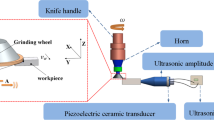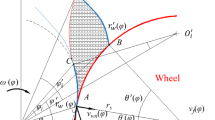Abstract
Single abrasive particles ultrasonic vibration grinding serves as the foundation for investigating the ultrasonic vibration grinding process. This paper proposes an innovative semi-analytical model, known as the ultrasonic vibration grinding heat transfer analysis (UVGHTA) model, which accurately predicts the temperature field in single abrasive particles ultrasonic vibration grinding with complex motion-induced heat sources. Firstly, a Gaussian-shaped heat source model is established for the grinding zone. Then, the alternating direction implicit (ADI) scheme of the finite difference method is employed to solve the heat conduction partial differential equations with ultrasonic heat source load boundary conditions. During the numerical iteration process, a synchronized additional method for heat sources is introduced to incorporate the temperature rise caused by the continuously moving heat source into the calculations, resulting in a complete semi-analytical predictive model that accurately simulates the dynamic temperature field in ultrasonic vibration grinding. Finally, the temperature field calculation results of the proposed model are compared with the finite element software calculation results and the experimentally measured temperature values for verification. This study addresses the challenge of predicting the temperature field in single abrasive particles ultrasonic grinding and provides a new approach to predicting the work surface temperature field in the heat transfer process involving multi-dimensional motion-induced time-varying heat sources.
















Similar content being viewed by others
References
Abdullah A, Sotoodezadeh M, Abedini R, Fartashvand V (2013) Experimental study on ultrasonic use in dry creep-feed up-grinding of aluminum 7075 and Steel X210Cr12[J]. Int J Precis Eng Man 14(2):191–198. https://doi.org/10.1007/s12541-013-0027-9
Bian P, Zhao B, Li Y (2009) Experimental temperature studies on two dimensional ultrasonic vibration grinding the nano-ZrO 2 ceramics[J]. Key Eng Mater 416:540–545. https://doi.org/10.4028/www.scientific.net/KEM.416.540
Zhou W, Tang J, Shao W, Wen J (2022) Towards understanding the ploughing friction mechanism in ultrasonic assisted grinding with single grain[J]. Int J Mech Sci 222. https://doi.org/10.1016/j.ijmecsci.2022.107248
Zhou W, Tang J, Li Z, Shao W, Wen J, Huang W (2023) Study on scratch hardness in ultrasonic vibration-assisted scratching based on instantaneous contact analysis[J]. Wear 528–529:204991. https://doi.org/10.1016/j.wear.2023.204991
Huang W, Tang J, Zhou W, Shao W, Yi M, Zhao X, Wen J (2022) Revealing nanoscale material deformation mechanism and surface/subsurface characteristics in vibration-assisted nano-grinding of single-crystal iron[J]. Appl Surf Sci 597:153692. https://doi.org/10.1016/j.apsusc.2022.153692
Ma K, Zhu X, Cui X, Wang J, Yu R, Xiao L, Alamir M, Ye L, Li X (2020) Experimental investigation on surface quality in ultrasonic-assisted honing of 304 stainless steel[J]. Precis Eng 63:148–158. https://doi.org/10.1016/j.precisioneng.2020.02.006
Zhou W, Tang J, Chen H, Shao W (2019) A comprehensive investigation of surface generation and material removal characteristics in ultrasonic vibration assisted grinding[J]. Int J Mech Sci 156:14–30. https://doi.org/10.1016/j.ijmecsci.2019.03.026
Zhou W, Tang J, Shao W (2020) Modelling of surface texture and parameters matching considering the interaction of multiple rotation cycles in ultrasonic assisted grinding[J]. Int J Mech Sci 166 https://doi.org/10.1016/j.ijmecsci.2019.105246
Wen J, Tang J, Zhou W (2021) Study on formation mechanism and regularity of residual stress in ultrasonic vibration grinding of high strength alloy steel[J]. J Manuf Process 66:608–622. https://doi.org/10.1016/j.jmapro.2021.04.040
Mizutani M, Xu S, Shimada K, Kuriyagawa T (2018) Micro-/nano-texturing by ultrasonic-assisted grinding. In J. Yan (Ed.), Micro and Nano Fabrication Technology (pp. 1–55). Springer Singapore. https://doi.org/10.1007/978-981-10-6588-0_8-2
Zhao B, Chang B, Wang X, Bie W (2019) System design and experimental research on ultrasonic assisted elliptical vibration grinding of Nano-ZrO2 ceramics[J]. Ceram Int 45(18):24865–24877. https://doi.org/10.1016/j.ceramint.2019.08.273
Wen J, Tang JY, Shao W, Zhou WH, Huang WW (2023) Towards understanding subsurface characteristics in burn process of gear profile grinding[J]. Materials 16(6). https://doi.org/10.3390/ma16062493
Zhang ZY, Shang W, Ding HH, Guo J, Wang HY, Liu QY, Wang WJ (2016) Thermal model and temperature field in rail grinding process based on a moving heat source[J]. Appl Therm Eng 106:855–864. https://doi.org/10.1016/j.applthermaleng.2016.06.071
Jiang J, Ge P, Sun S, Wang D, Wang Y, Yang Y (2016) From the microscopic interaction mechanism to the grinding temperature field: an integrated modelling on the grinding process[J]. Int J Mach Tool Manu 110:27–42. https://doi.org/10.1016/j.ijmachtools.2016.08.004
Chen T, Ye M, Liu S, Tian S (2017) Measurement of ultrasonic assisted grinding temperature based on fiber Bragg grating (FBG) sensor[J]. Int J Adv Manuf Tech 93(5–8):2561–2570. https://doi.org/10.1007/s00170-017-0721-3
Gostimirovic M, Sekulic M, Trifunovic M, Madic M, Rodic D (2021) Stability analysis of the inverse heat transfer problem in the optimization of the machining process[J]. Appl Therm Eng 195. https://doi.org/10.1016/j.applthermaleng.2021.117174
Thi-Thao N, Huang JH, Than V-T, Wang C-C (2017) A BFGS and simple step method for estimating the interface temperature in 2D ultrasonic seam welding[J]. Appl Therm Eng 115:1031–1044. https://doi.org/10.1016/j.applthermaleng.2017.01.034
Dai S, Wang X, Zhang H, Wen B (2021) Research on variation of grinding temperature of wind turbine blade robotic grinding[J]. P I Mech Eng B-J Eng 235(3):367–377. https://doi.org/10.1177/0954405420972988
Jamshidi H, Budak E (2018) Grinding temperature modeling based on a time dependent heat source[J]. Procedia CIRP 77:299–302. https://doi.org/10.1016/j.procir.2018.09.020
Wen J, Zhou WH, Tang JY, Shao W (2022) Residual stress evolution for tooth double-flank by gear form grinding[J]. J Manuf Process 77:754–769. https://doi.org/10.1016/j.jmapro.2022.03.058
Zhu C, Gu P, Wu Y, Tao Z (2020) Grinding temperature prediction model of high-volume fraction SiCp/Al composite[J]. Int J Adv Manuf Tech 111(5–6):1201–1220. https://doi.org/10.1007/s00170-020-06098-9
Paknejad M, Abdullah A, Azarhoushang B (2017) Effects of high power ultrasonic vibration on temperature distribution of workpiece in dry creep feed up grinding[J]. Ultrason Sonochem 39:392–402. https://doi.org/10.1016/j.ultsonch.2017.04.029
Chen J, Fu Y, Qian N, Jiang H, Ching CY, Ewing D, Dai C (2021) Investigation on cooling behavior of axially rotating heat pipe in profile grinding of turbine blade slots[J]. Appl Therm Eng 182. https://doi.org/10.1016/j.applthermaleng.2020.116031
Kuriyagawa T, Syoji K, Ohshita H (2003) Grinding temperature within contact arc between wheel and workpiece in high-efficiency grinding of ultrahard cutting tool materials[J]. J Mater Process Tech 136(1–3):39–47. https://doi.org/10.1016/s0924-0136(02)00842-7
You F, Shen J, Xu X (2009) A method for calculating the maximal temperature of single grain though analyzing the grinding temperature signal[J]. Key Eng Mater 416:98–102. https://doi.org/10.4028/www.scientific.net/KEM.416.98
Zhang H, Kuai J (2017) Modeling analysis of temperatures at points in oxide film of grinding wheels[J]. IOP Conf Ser: Mater Sci Eng 170:012025. https://doi.org/10.1088/1757-899X/170/1/012025
Bergs T, Roettger J, Barth S, Prinz S (2021) Approach to the numerical modelling of the chip temperatures in single grain scratching[J]. Prod Eng-Res Dev 15(3–4):451–455. https://doi.org/10.1007/s11740-021-01017-7
Tang J, Du J, Chen Y (2009) Modeling and experimental study of grinding forces in surface grinding[J]. J Mater Process Tech 209(6):2847–2854. https://doi.org/10.1016/j.jmatprotec.2008.06.036
Kumar VC, Hutchings IM (2004) Reduction of the sliding friction of metals by the application of longitudinal or transverse ultrasonic vibration[J]. Tribol Int 37(10):833–840. https://doi.org/10.1016/j.triboint.2004.05.003
Tsai CC, Tseng CH (2006) The effect of friction reduction in the presence of in-plane vibrations[J]. Arch Appl Mech 75(2–3):164–176. https://doi.org/10.1007/s00419-005-0427-0
Malkin S, Anderson RB (1974) Thermal aspects of grinding: Part 1—Energy Partition[J]. J Eng Ind 96(4):1177–1183. https://doi.org/10.1115/1.3438492
Courbon C, Mabrouki T, Rech J, Mazuyer D, D’eramo E (2013) On the existence of a thermal contact resistance at the tool-chip interface in dry cutting of AISI 1045: formation mechanisms and influence on the cutting process[J]. Appl Therm Eng 50(1):1311–1325. https://doi.org/10.1016/j.applthermaleng.2012.06.047
Li C, Zhao S (2017) A matched Peaceman-Rachford ADI method for solving parabolic interface problems[J]. Appl Math Comput 299:28–44. https://doi.org/10.1016/j.amc.2016.11.033
Jin T, Yi J, Li P (2017) Temperature distributions in form grinding of involute gears[J]. Int J Adv Manuf Tech 88(9–12):2609–2620. https://doi.org/10.1007/s00170-016-8971-z
Lin Z (1987) Ultrasonic horn of the principles and design [M]. Science Press, Beijing
Funding
The authors gratefully acknowledge the support of the National Natural Science Foundation of China (NSFC) through Grants No. U22B2086.
Author information
Authors and Affiliations
Contributions
All authors contributed to the study conception and design. Material preparation, data collection, and analysis were performed by Runxiang Zou, Jun Wen, and Jinyuan Tang. The first draft of the manuscript was written by Runxiang Zou and all authors commented on previous versions of the manuscript. All authors read and approved the final manuscript.
Corresponding author
Ethics declarations
Competing interests
The authors declare no competing interests.
Additional information
Publisher's Note
Springer Nature remains neutral with regard to jurisdictional claims in published maps and institutional affiliations.
Rights and permissions
Springer Nature or its licensor (e.g. a society or other partner) holds exclusive rights to this article under a publishing agreement with the author(s) or other rightsholder(s); author self-archiving of the accepted manuscript version of this article is solely governed by the terms of such publishing agreement and applicable law.
About this article
Cite this article
Zou, R., Wen, J., Tang, J. et al. A new semi-analytical prediction model for temperature field of ultrasonic vibration grinding of single abrasive particles. Int J Adv Manuf Technol 129, 697–714 (2023). https://doi.org/10.1007/s00170-023-12308-x
Received:
Accepted:
Published:
Issue Date:
DOI: https://doi.org/10.1007/s00170-023-12308-x




